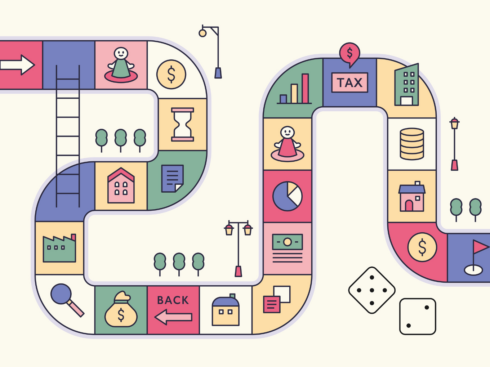
At some point, most startup founders have experienced the feeling of being lulled to sleep by the siren song of early success or the insanity of business expansion.
You know the feeling – when good results are flowing in so frequently that you forget the importance of striving for great ones, or when you’re too busy fighting small fires to recognize the conflagrating blaze cropping up behind you. Sure, you’re doing what you can to build a great company and you’re achieving progressively bigger wins.
But in the process of sprinting through the sometimes-unavoidable expansion-stage rabbit hole, tunnel vision sets in and it causes you to lose focus on something else. Namely, the fact that your biggest competitors aren’t worrying about little wins or small fires. Instead, they’re focused on executing targeted business growth strategies, gaining brand equity in your market, and quickly acquiring more customers.
Slowly but surely, those things help them beat you. And, before too long, they’re in a position to kill your once-promising startup dream…
The Frog and the Frying Pan
The analogy I like to use to describe this common founder mistake is the anecdote of a frog in a frying pan. As the heat slowly rises, the change in temperature is often too subtle to notice, so the frog stays put. The heat gets cranked up some more, but, again, it’s a slow burn and the frog’s body adjusts and adapts to the increased heat.
The problem for the frog, of course, is that on a second-by-second basis the change in heat doesn’t seem that bad. From a broader perspective, however, the reality is unavoidable: the frog is getting cooked and, by the time it realizes what’s happening, the damage is done.
7 Strategies Successful Companies Use to Squash Competition
So, what can you do to avoid getting burned by your competitors?
For starters, it’s important to be aware of the seven things smart competitors do to eat upstart competition for lunch:
1. Developing target insights – Because the company with the best insight and execution generally wins, your key competitors know how important it is to learn as much as they can about their target markets. They’ll do their research, find their best target customers, and pinpoint the market segment they want to win. Unfortunately for you, that segment is often the one you should be targeting, too.
Once your competitors understand that target segment, they’ll research the users in it, develop a great understanding of them, and identify some really important insights to design and deliver better whole product strategies and tactics. Likewise, they’ll also research the buyers in that segment and understand the buyer roles, personas, buying process, and reasons for buying in greater detail. They also study the marketing channel targets, influencer targets, and sales channel targets to generate an intelligent and structured go-to-market strategy.
Finally, your competitors will research you. They’ll study what you’re doing in that market segment, talk to your buyers and users, pinpoint your strengths and weaknesses, and develop a strategy to capitalize on what you’re not doing well. Meanwhile, if you’re focusing on achieving little wins or putting out inconsequential fires, your insight into the market (and your competitors will be limited. Sure, you may have done some cursory research, but how much insight did that really generate? And did you actually act on it?
The frying pan is heating up…
2. Focusing on product design – Your competitors know that designing the best product for their target customer segment is a great long-term strategy. So, they’ll carve a product management function out of development and form a product council consisting of representatives from product management, sales, marketing, customer service, and professional services. Those departmental representatives will be responsible for collecting intelligence and ideas, and developing a plan-of-action to improve the whole product. Next, your competitors will put together a UX/UI team to research, design, test, and improve user experience and ensure the whole product is intuitive and easy to implement.
Meanwhile, your product design decisions are being made by yourself (the founder) or your head of development, and you have little or no staff to research, design, test, and iterate on your product. While that was fine when you were a startup, you really need a team of people dedicated to product design if you hope to fend off well-established and funded competition.
The frying pan is getting hotter…
3. Studying how they fit into the ecosystem – Your competitors realize that they don’t have a stand-alone product, but rather one that fits within an ecosystem of products that their target market uses or wants to use. So, they hire the best business development/demand gen person in the market to attack this opportunity, and they also begin building teir relationships with the other companies in the ecosystem – integrating their products into it, and offering easy-to-use APIs for other participants to integrate into and extend their product.
In addition, your competitors establish marketing and co-marketing arrangements with the most important members of the ecosystem. They realize that Internet, SaaS, cloud-based business models, and mobile platforms are gaining a lot of traction and they have been innovating to find the new ecosystem partners and platform extensions that will further increase their lead.
Meanwhile, you haven’t realized this opportunity (or you have and are doing very little to capitalize on it). You don’t have a business development or demand gen lead (or you have hired a second-tier player), so other members of your senior team are taking on the role part-time. As a result, you’re generally playing catch-up against your top competitors and falling further and further behind.
The frying pan is beginning to sizzle…
4. Using Scrum effectively – Your competitors know that Scrum is a game-changer for their product efforts (promising to increase productivity by as much as 400%) and begin the process of fully adopting it. They take the effort seriously, train all of their developers on the technique, hire people onto the team who have Scrum experience, and let go any team members who can’t keep up.
Not only that, senior management promises to do everything in its power to remove obstacles and increase the team’s velocity. As a result, the competitors’ product releases happen more frequently and are higher-quality than yours. In fact, your competitors understand the power of Scrum so well that they have started using a scrum-like approach to help them manage every facet of their business, not just their software development.
Meanwhile, you think you’re doing Scrum, but your team can’t even pass the Nokia test(and perhaps doesn’t even know about it). You aren’t focused on improving the situation. Your management team thinks of development as a black box and isn’t helping you to get better. You may not even be calculating your velocity, so you don’t even know how low it is.
The frying pan is starting to burn…
5. Following the rules of marketing – Your competitors understand that there are 10 fundamental rules of marketing and they’re nailing every aspect of their marketing program. The market is quickly getting to know them and it likes them a lot.
Meanwhile, your marketing department has been narrowly focused on leads, leads, and more leads and relies on a narrow set of marketing channels (perhaps even just using Adwords). In the worst cases, your competitive messaging strategy might even fall into the trap of telling people in the market that you’re just like <insert name of your key competitor>.
You’re starting to cook…
6. Building a sales factory. Your competitors knew they could gain a competitive advantage if they built a methodology for selling that was world class, repeatable, scalable, and that resulted in a great economic model.
If you’re in the e-commerce space, your competitors are conversion rate experts, they understand every prospect click, and they’ve truly optimized their sales. If you’re in B2B, your competitors are building a sales factory like Oracle or Salesforce.com – executing the very best modern selling systems and hiring the best talent in the industry.
You, on the other hand, are still relying on the haphazard, unstructured, shoot-by-the-seat-of-your pants sales strategy that worked in the startup phase. The question, however, is whether that strategy will work against your competitors’ hyper-focused, smartly staffed sales factory.
You’re beginning to really feel the heat…
7. Assembling great teams, boards, and advisors – Finally, your key competitors recognize that people are at the core of everything they do and begin to hire the absolute best talent for every role in their business. Importantly, they also surround those people with the best board members and outside advisors to help connect the company with the best ideas and resources. They even establish clear, compelling, and shared aspirations for their company that help their team work toward common goals.
Meanwhile, you’ve hired some good people and your founding team is strong, but some combination of loyalty and priority is preventing you from making the adjustments to your team that would really move the needle.
You’re toast…
Be the Frying Pan, Not the Frog
Ultimately, competition in business is unavoidable and your key competitors will align the strategies listed above to create a razor-tipped, titanium arrow directed at your market. Maybe they won’t knock you off your perch right away, but they won’t stop firing until you’ve been eradicated as a threat.
The question, then, is what you plan to do about it?
Will you maintain status quo and continue to rely on the approach that’s gotten you to this point? Or will you evolve and take a proactive and tactical approach to growth? The reality is that companies that do the latter are the ones that win. They create their own advantages, set the pace for the market, and force everyone else to respond to them.
The good news is that if you’re the frog in the frying pan right now, there’s probably still time for you to escape. By implementing the strategies above – proven approaches that have been used by several of our most successful portfolio companies – you can seize the opportunity to become the company holding the frying pan, instead of the one being cooked in it.



























